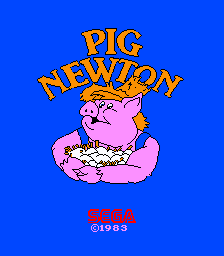Difference between revisions of "Pig Newton"
From Sega Retro
(so why are we missing several revisions of the game) |
|||
| (2 intermediate revisions by 2 users not shown) | |||
| Line 4: | Line 4: | ||
| developer=[[Sega Electronics]] | | developer=[[Sega Electronics]] | ||
| system=[[Sega G80]] | | system=[[Sega G80]] | ||
| − | |||
| sounddriver= | | sounddriver= | ||
| peripherals= | | peripherals= | ||
| players=1 | | players=1 | ||
| genre=Action | | genre=Action | ||
| − | | releases={{ | + | | releases={{releasesArcade |
| − | | | + | | g80_date_us=1983 |
}} | }} | ||
}} | }} | ||
| − | {{sub-stub}}''''' | + | {{sub-stub}}'''''{{PAGENAME}}''''' is an arcade game developed by [[Sega]] for [[Sega G80]] hardware in 1983, based on Malcom Hancock's ''[[wikipedia:Pig Newton|Pig Newton]]'' cartoon. The game takes place in a tree, where the player must drop apples on wolves below to stop them cutting it down. It apparently did not survive past testing{{ref|http://gdri.smspower.org/wiki/index.php/Talk:Sega_Electronics}}. |
| − | ==Physical | + | ==Physical scans== |
| − | + | ==References== | |
| + | <references/> | ||
Latest revision as of 07:55, 13 July 2018
| Pig Newton | |||||||||
|---|---|---|---|---|---|---|---|---|---|
| System(s): Sega G80 | |||||||||
| Publisher: Sega | |||||||||
| Developer: Sega Electronics | |||||||||
| Genre: Action | |||||||||
| Number of players: 1 | |||||||||
|
This teeny-tiny article needs some work. You can help us by expanding it.
Pig Newton is an arcade game developed by Sega for Sega G80 hardware in 1983, based on Malcom Hancock's Pig Newton cartoon. The game takes place in a tree, where the player must drop apples on wolves below to stop them cutting it down. It apparently did not survive past testing[1].
